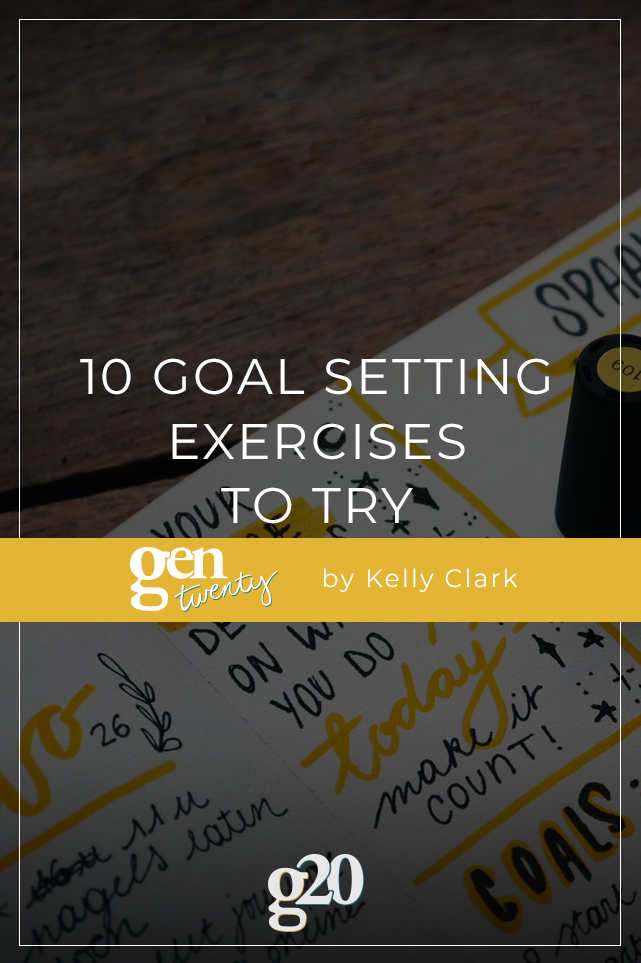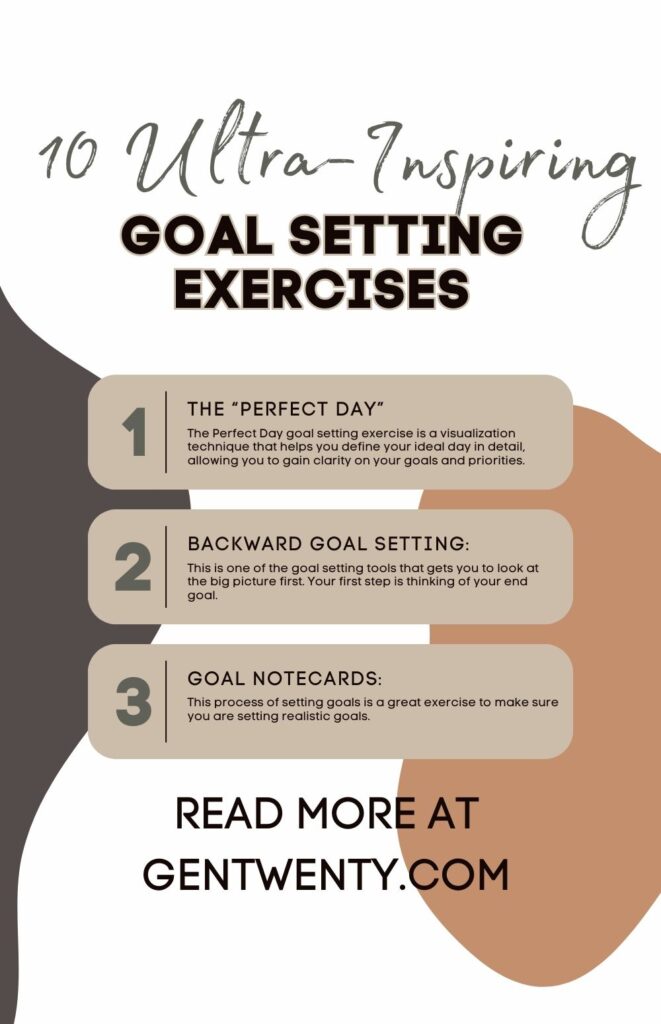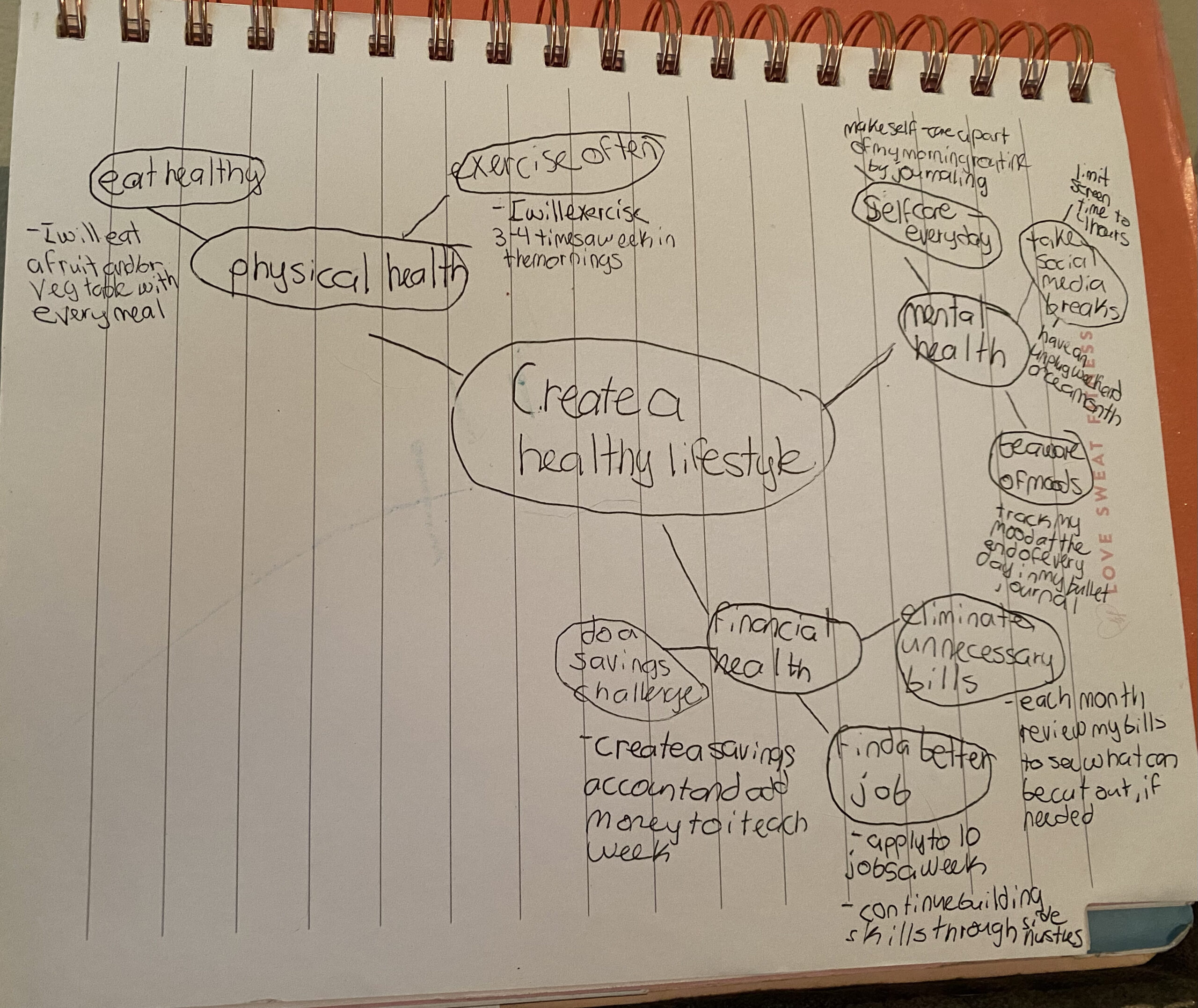Whether you believe in claiming a New Year’s Resolution or not, odds are you have thought about what this new year has in store for you at least once or twice. It’s at this time of year where resolutions, goals, and new habits are at the forefront of everyone’s mind, I wanted to give you some tips and tricks to help.
The new year’s energy and motivation only last so long. In order to follow through with these intentions, you’ve got to take the time to work through them.
Setting goals is key for your personal development and it’s one of the best ways to bring a personal goal from idea to reality. That’s where these goal setting exercises come in handy.
These 10 effective goal setting activities you can use to visualize, determine, and track the goals you need for an accomplished year!
10 Ultra Effective Goal-Setting Exercises To Reach All of Your Goals
1. Goals Journal
The first goal-setting exercise is a goals journal. You could technically do this exercise on anything, even a napkin, but I’d recommend you get a notebook just for writing down your goals.
Each morning make some time to write down your goals for the year. Write them down each morning, then repeat these goals out loud. It’s really as simple as that.
The reason behind this daily activity is that you have a better chance to achieve your goals by writing them down. Need more reasons? Having a notebook just for goal setting shows you how much this goal, or goals, mean to you. You’ll be able to check off the ones you’ve achieved throughout the year.
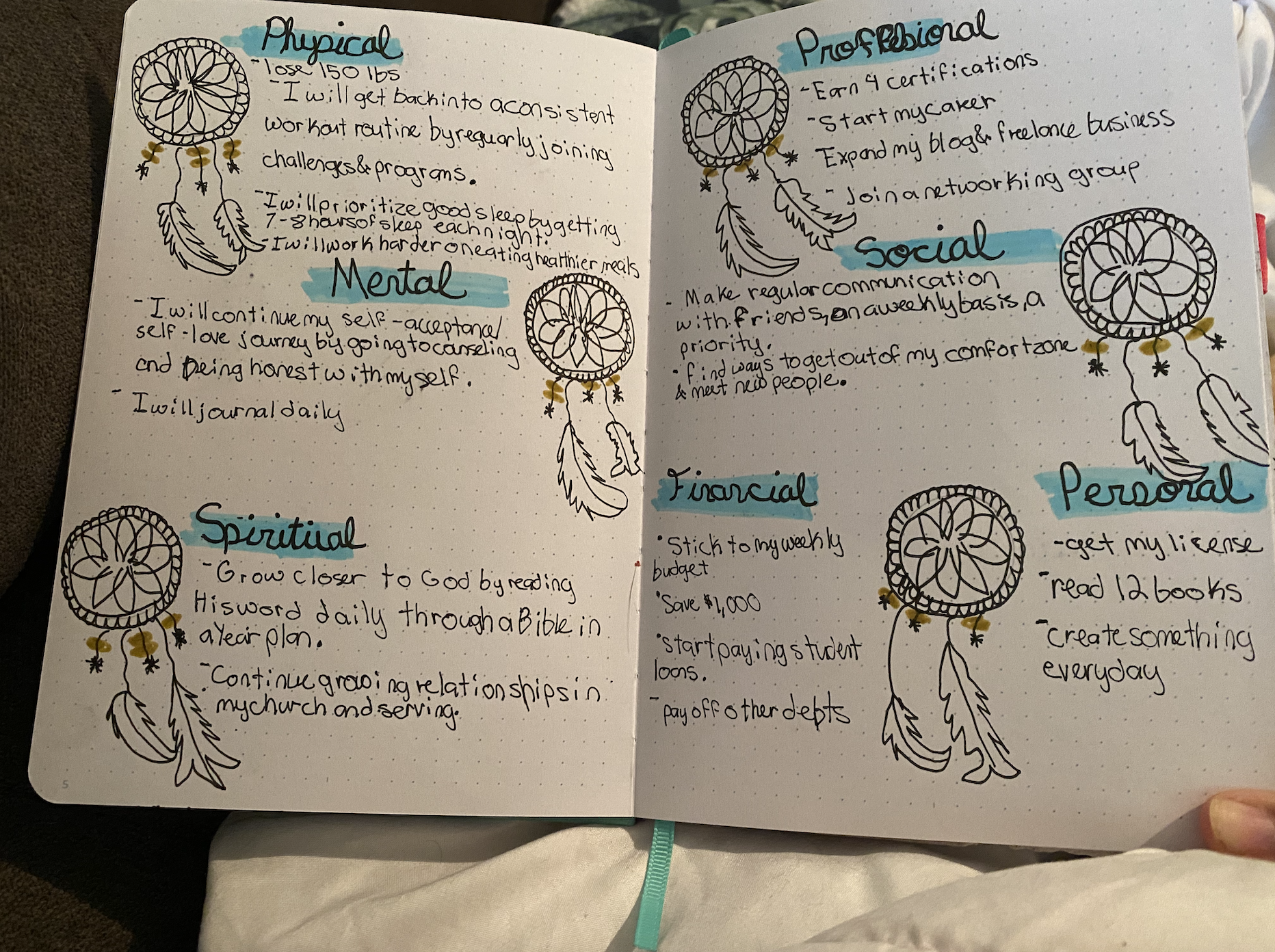
2. SMART Goals Method
We’ve talked about SMART goals before here at GenTwenty. In case you aren’t familiar with what SMART goals are, I’ll break it down for you. These are goals that are Specific, Measurable, Attainable, Relevant, and Time based.
SMART goal setting is an effective way to create personal goals, and even professional goals as well. Getting into the nitty-gritty of what you want to accomplish will give you more direction and motivation to achieve said goal.
For example, the goal of “getting a new job” isn’t nearly as direct as, “I will apply to 10 jobs each week to improve my chances of gaining a new job.” We’ve made it easy for you to brainstorm your own more specific goals by creating a goal setting worksheet for you to use. You can download the SMART Goals Worksheet here: SMART Goals Worksheet
3. CLEAR Goal Setting Method
This goal setting method is great for achieving business goals, specifically. This method can be used by teams, study groups, basically any type of group working towards achieving a goal.
The CLEAR goal-setting method is a structured approach to setting and achieving goals. The acronym “CLEAR” stands for:
- C: Collaborative – This emphasizes involving others in the goal-setting process. It suggests that goals are more likely to be achieved when there is collaboration, support, and input from relevant stakeholders.
- L: Limited – This emphasizes the importance of setting clear and specific goals. Goals should be well-defined and focused, rather than vague or overly broad. When goals are limited in scope, they are easier to understand and work towards.
- E: Emotional – This highlights the significance of having an emotional connection or motivation behind a goal. When a goal has personal meaning or resonates emotionally, individuals are often more motivated and committed to achieving it.
- A: Appreciable – This emphasizes breaking down larger, long-term goals into smaller, manageable chunks or milestones. By doing so, the goal becomes more approachable and progress can be tracked more effectively.
- R: Refinable – This suggests that goals should not be set in stone. Instead, they should be flexible and open to adjustment or refinement as circumstances change or as new information becomes available.
By following the CLEAR method, individuals or teams can create goals that are specific, emotionally meaningful, collaboratively supported, broken down into manageable pieces, and adaptable over time. This structured approach helps increase the likelihood of successful goal achievement.
It takes into account how businesses have changed over the years. This method is great to get all team members on the same page through goal setting. Learn more about the CLEAR method, and how it compares to SMART goals, by reading this post.
4. Vision Board
You are most likely familiar with this activity. If you have never created a vision board for what you want to achieve and experience this year, this is your sign to create one this year.
Don’t be afraid to get creative and let your mind flourish when thinking about what to add to your vision board. Cut out pictures from magazines, or print some fun fonts out, you can create your vision board however you want.
Once it’s done hang it somewhere you’ll see it everyday. Take time to look at your vision board and all of the different types of goals included there.
5. Mind Mapping
Next on our goal-setting activities list is mind mapping. This tool is a useful way to boil down your big goal, or goals, into actionable steps.
Remember in high school when we would be tasked with writing a paper? One of the brainstorming methods was creating a mind map. This activity can work for your goals too.
Whether the main bubble is this year in general, or goals for certain areas of life, like fitness goals or career goals, they all break down the same way. This activity is a great way to set more meaningful goals.
Here is an example of my mind map for the year. You see how the first goal is broad and the further out you go the more specific the goal gets. Those last steps in your mind map are the actions to take to make those positive changes and achieve your goal.
6. Perfect Day
This next activity in our list of goal-setting tools is in the form of a simple question. ”What does your perfect day look like?”
The Perfect Day goal setting exercise is a visualization technique that helps you define your ideal day in detail, allowing you to gain clarity on your goals and priorities. Here’s how it works:
- Set Aside Time: Find a quiet place where you can relax and focus without distractions. Set aside at least 15-30 minutes for this exercise.
- Imagine Your Perfect Day: Close your eyes and imagine waking up in the morning feeling refreshed and energized. Picture yourself going through your day, from start to finish, in as much detail as possible.
- Include All Aspects of Your Life: Think about all areas of your life, such as work, relationships, health, and leisure. Imagine how you would spend your time in each area and how you would feel throughout the day.
- Focus on Feelings: Pay attention to how you feel during your perfect day. Notice the emotions that arise as you go through each activity and interaction.
- Write It Down: After you’ve completed the visualization, write down a detailed description of your perfect day. Include specific activities, feelings, and experiences that are important to you.
- Identify Themes and Priorities: Review your description and identify any themes or priorities that stand out to you. These can help guide you in setting goals and making decisions that align with your ideal life.
- Set Goals Based on Your Vision: Use the insights from your perfect day visualization to set goals that will help you create a life that aligns with your vision. Break these goals down into actionable steps and create a plan to achieve them.
By visualizing your perfect day, you can gain clarity on what truly matters to you and create a roadmap to turn your dreams into reality. Here are a few questions to consider while completing the exercise:
- What time do you wake up?
- What do you eat for breakfast?
- What is your morning routine like?
- When do you start work?
- What do you do for work?
- What do you do after work?
- Do you spend time on hobbies or interests?
- What does your friend and family time look like?
- How do you wind down for bed?
- What time do you go to bed?
Being specific with your perfect day can help you determine some goals to work toward. For example, if on your perfect day you wake up at 6am, but currently you are peeling yourself from your bed at 8am, a goal for you could be waking up earlier.
You could achieve this by thinking of what you’d like to achieve in that extra time. Maybe you would like to spend that time reading. There is another goal, read X books this year. You see how these goals are starting to appear through this little exercise?
7. Backward Goal Setting or Reverse Goal Setting
This is one of the goal setting tools that gets you to look at the big picture first. Your first step is thinking of your end goal. By the end of the year what do you want to accomplish?
Backward goal setting, also known as reverse goal setting, is a goal-setting method that involves starting with a clear vision of the end goal and then working backwards to determine the steps needed to reach that goal. Here’s how it works:
- Define Your End Goal: Start by clearly defining your ultimate goal. This could be a long-term goal, such as graduating from college, starting a business, or losing a certain amount of weight.
- Break It Down: Once you have your end goal in mind, break it down into smaller, more manageable goals or milestones. These could be monthly, weekly, or even daily goals that will help you progress towards your ultimate goal.
- Identify Key Actions: For each milestone, identify the key actions or steps you need to take to achieve it. These should be specific, measurable, achievable, relevant, and time-bound (SMART) goals.
- Set Deadlines: Assign deadlines to each milestone and key action. This will help keep you on track and motivated to achieve your goals.
- Work Backwards: With your milestones, key actions, and deadlines in place, work backwards from your end goal to determine the sequence of steps needed to reach it. This will help you create a clear roadmap to success.
- Monitor Progress: Regularly monitor your progress towards your goals and adjust your plan as needed. Celebrate your successes along the way to stay motivated.
By using backward goal setting, you can create a clear and actionable plan to achieve your goals, helping you stay focused and motivated as you work towards success.
By focusing on the final destination and working backwards you are able to create a clear action plan. You’ll determine specific actions and necessary steps needed to reach that big goal. The great thing about this goal-setting process is that it already gets you in the growth mindset of the person you need to be to achieve your goal.
For an example of how backward goal setting works, let’s say your goal is changing career paths. You’ve been working in sales but you’ve always had a passion for graphic design, and now you are ready to explore that. So your ultimate goal could be to get a job as a graphic designer at an ad agency.
Here is how your goal setting process could look. Download a copy of this goal setting worksheet here: Backward Goal Setting
8. One Word Resolution
This activity is similar to the mind mapping one. With this activity you set goals based on one word. It’s a simple method of setting goals, but it’s effective as well. The first step is to choose a word that you want to define your year.
Some examples are fearless, growth, joy, flourish, and peace. Next take each area of your life (health, career, relationships, etc.) and ask yourself, “How can I be more ____?”
In the answers to those questions you’ll find your new goals and the small steps that lead to them. I like to do this activity in the first few pages of my bullet journal each year. Consider your personal values when choosing your word. It can help you connect to the bigger picture and also give you a visual representation of what you want your year to look like.
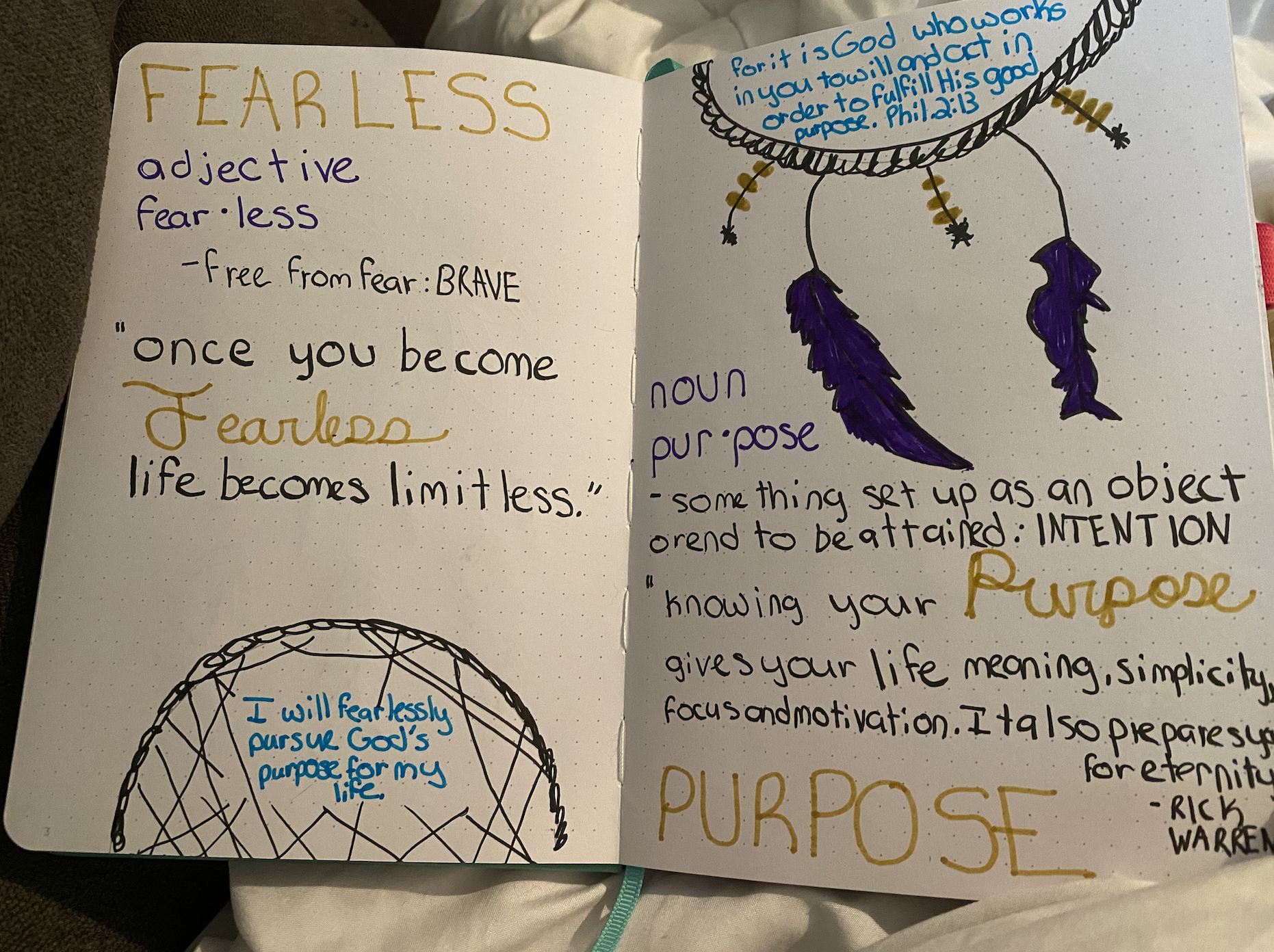
9. Habit Tracker
Most new year’s resolutions are surrounded by a habit. Whether it’s breaking a bad one, or creating a good habit, these goals center around a certain activity. To get your resolutions started in the right direction, you’ll want to come up with a way to stay progressing on your habit.
You can do this through a habit tracker. There are many different ways to create a habit tracker. It can be as simple as a checkmark on each day in your calendar. I like to get creative with mine and create doodles to display my own goals.
The key is that you want to come back to your habit tracker on a daily basis to get the biggest impact on your life.
10. Goal Notecards
We’ve made it to the finish line! This is the last goal setting exercise on today’s list. This activity is a great opportunity for people that are goal-obsessed to narrow down to the most important goals.
Take some time to write a giant list of goals you have on notecards, one for each goal. Once you are done it’s time to make the first cut. Shuffle your cards and go through them.
Put them into piles, one being goals you want to achieve, and one pile being goals you aren’t that excited about. Take the first pile and repeat the process. This time we are going for certainty.
Which goals are you definitely wanting to pursue in this new year? Those are your goals to focus on.
This process of setting goals is a great exercise to make sure you are setting realistic goals. I believe this is the best tool for anyone questioning what goals they want to achieve this year.
What Goal Setting Exercises Speak To You?
In conclusion, goal setting exercises can be incredibly powerful tools for clarifying your vision, boosting motivation, and achieving success. Whether you prefer the SMART method, visualization techniques, or backward goal setting, the key is to find a method that resonates with you and aligns with your goals.
Now that you have all the tools you need to create effective goals this year, which activity will you be using to create better goals? Whichever one you choose, I’m sure your future self will thank you for introducing new daily habits and positive changes through new goals.
By setting clear, achievable goals and breaking them down into actionable steps, you can turn your dreams into reality. So, why wait? Start setting goals today and take the first step towards a brighter, more fulfilling future.
